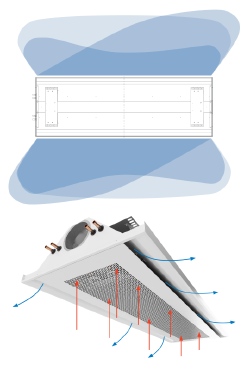Optimizing the design of active chilled-beam systems

Active chilled beams are finding increasing use in office and commercial buildings. They use a variety of solutions for air diffusion, adjustability and efficiency. By combining these in a smart way and adding new thinking, the optimal chilled-beam design can be achieved. Professor Göran Hultmark of Lindab explains.
Active chilled beams work on the induction principle. Introducing flow of ventilation air through the beam's nozzles creates a low static pressure in the beam. This, in turn, causes the room’s warm air to be induced into the stream of ventilation air after first passing through the beam’s battery. This induction effect creates a volume of circulated air in the room two to seven times larger than the air from the ventilation duct itself.
The nozzle design, air direction and air-volume regulation of the chilled beam play an important role in its operational characteristics.
Optimal nozzle technical/aerodynamic design provides low pressure drop, high exit velocity and an even air jet pattern. This ensures high induction, but also assures low noise.
The most used nozzle design is round nozzle with an inner diameter of 4 to 8 mm, which gives excellent aerodynamic performance — resulting in low pressure drop, an even air jet and low noise generation. As a general rule, the smaller the nozzle, the better the properties. By comparison with the nozzle a simple flat round hole design has significant adverse affects on pressure drop, air speed and jet pattern, resulting in lower induction rates.
 |
| Round nozzle |
 |
| Round hole |
 |
| Round nozzle with JetCone |
A round nozzle equipped with JetCone regulation presents optimal results giving high induction as well as high cooling capacity.
To achieve maximum comfort with low air speeds in the occupied zone, the air from the chilled beam needs to be directed. This is typically associated with draught problems, or when refurbishments or layout modifications adversely affect airflow. However, different air-direction controls give a variety of results, some with negative effects on efficiency.
Rotating guide vanes can be set individually or in groups and allow for air direction angles of up to 30°. This makes it possible to set a fan-shaped air-diffusion pattern; however, this results in a cooling/heating coil capacity drop of 5 to 10% compared to straight 0° air direction. The same results can be achieved with height-adjustable vanes, but also with a 5 to 10% capacity drop.
Fixed eyebrow nozzles can normally be factory set in angles ranging from 0 to 30°, but cannot be adjusted at a later time, should the need arise.
Finally, air direction through fixed, round, angled nozzles is not adjustable, but their ideal shape incurs no capacity losses.
Adjusting the air volume in chilled beams is currently achieved primarily in the following ways.
Using oblong slot openings provides quick and easy air-volume adjustment, with separate settings for each opening. However, due to poor aerodynamics, the pressure loss is considerable.
A hit-and-miss damper that closes/opens round nozzles creates low pressure losses and low noise generation. The drawback is that only a few air-volume positions can be set. Using manually plugged nozzles is a common but more time-consuming and cumbersome method.
A more recent method is using JetCone adjustment. This solution uses round nozzles combined with JetCones, and has excellent properties in terms of both pressure losses and noise generation. The air volume is regulated quickly and easily and can be varied from 20 to 100%. The air volume can also be set separately on each side of the beam and varied linearly along its length.
Combining some of the above alternatives in nozzle design, air direction and volume adjustments, can achieve an optimal design of active chilled beam.
 |
| Modern chilled beams have variable and adaptable air-diffusion patterns. |
Using an angled nozzle with fully variable JetCone regulation gives a solution with high induction and, thus, high diffusion. 30° short, 16° medium and 0° long air direction settings, give optimal air diffusion for open-plan offices. Combined with fully variable air volume regulation, this solution meets today’s needs for flexibility and adaptation to new tenant demands. The result is a high level of comfort for any new tenant, at very low renovation costs and with short renovation times.
Lindab’s Premum and Premax chilled beams are good examples of today´s optimal chilled beam solutions. They use JetCone regulation, with easily adjusted air volume at each point along the entire length of the beam.
The linear shape of the JetCones makes it possible to maintain the air volume and change the beam’s air volume distribution by changing the setting at two locations.
In this way draught problems can easily be addressed, while maintaining the desired air volume.
Using Premum and Premax, optimal air diffusion, with full, variable air volumes can be achieved, and with an additional cooling capacity of 5 to 10% compared to vane directed beams.
Professor Göran Hultmark is a product-development specialist with Lindab.







